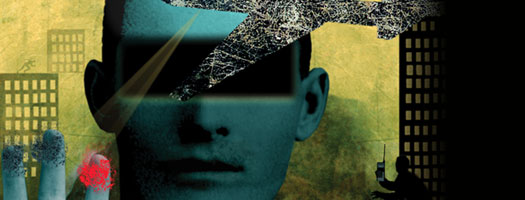Destroying to Protect
UTSA professors use virtual explosives to keep cities and soldiers safe
While Clutter is involved in computational fluid dynamics, which model the bomb explosions, Connolly is involved with dynamic systems modeling, which measures impact on the brain.
“I build a model of the brain and skull to measure what that pressure wave does to a human head,” Connolly says.
That’s important because medics often don’t know that a person has
received a brain injury until symptoms begin.
“If you ask the soldier, he’s going to tell you he’s fine and ready to go,” Clutter says. “He may have an injury where the brain begins to swell. If the doctors know that, they’ll actually cut out a piece of his skull, give the brain a chance to swell and then go down
again and then repair the skull. The problem is they don’t know if your brain is going to swell or not, and there’s no outward indication that it’s going to happen.”
The sensor they are developing will serve as that outward indication. By recording the intensity of the pressure wave, the sensor can provide a history of the force to which the soldier has been exposed.
“The troop doesn’t even have to be conscious,” Clutter explains. “The medic can plug the sensor in the soldier’s helmet right into a handheld computer and get an instant readout of what it’s been exposed to. He can then make an informed decision about whether that soldier’s brain is likely to have been
injured. Then there are lots of ways that [it] can be treated.”
Clutter’s devastated model of San Antonio has been presented to city
officials. He has a working prototype of his helmet sensor and is seeking additional funding to develop more
sophisticated models of the device.
Until that happens, Clutter will continue working in his virtual world, gradually making the real world safer
by doing what he loves—blowing things up.
— Randy Lankford
Illustration by Michael Morgenstern c/o theispot.com
 |
Keith Clutter
Assistant professor
of mechanical engineering
Interim director of UTSA’s Center
for Response and Security Engineering
and Technology
Keith Clutter’s teaching and research concern thermal fluid sciences, numerical modeling and combustion and explosives.
He has developed a computational fluid dynamics code that simulates explosions from gas and other explosives. With the code, he analyzes potential explosion scenarios and
conducts vulnerability assessments for various companies and organizations.
Clutter received his Ph.D. in aerospace engineering in 1997 from the University of Florida.
He was a United States Air Force Fellow in 2001. |
page 1 page2 page3 |



